Family : Solenostomidae

Text © Giuseppe Mazza

English translation by Mario Beltramini
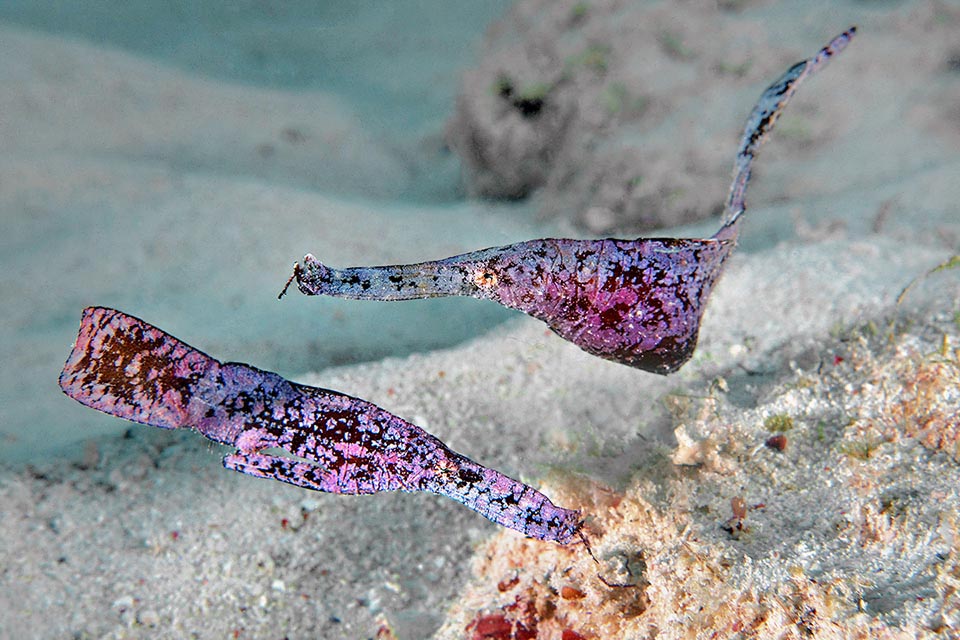
Thin like a leaf, the Robust ghost pipefish (Solenostomus cyanopterus) presents characters intermediate between seahorses and pipefishes © Rafi Amar
Mimicry is at home in the order of the Syngnathiformes.
As an example, let us look at gorgonians, so frequent in the multi-coloured world of the corals. On these live some tiny seahorses, such as the 2 cm Hippocampus bargibanti, that escape predators perfectly imitating their polyps, and thanks to its changeable camouflaging livery even their 80 cm greedy relative, Aulostomus chinensis, literally disappears vertically close to the big fans of these Alyonacea ready to surprise the unfortunate passing by fishes.
Then stand those imitating the green world. Master in this regard is undoubtedly the Leafy seadragon (Phycodurus eques) who when swimming calmly, predating without being predates, seems a tuft of drifting seaweeds, but in this strategy, in its own small way, also shines the Robust ghost pipefish (Solenostomus cyanopterus Bleeker, 1854), quite similar to a leaf fragment.
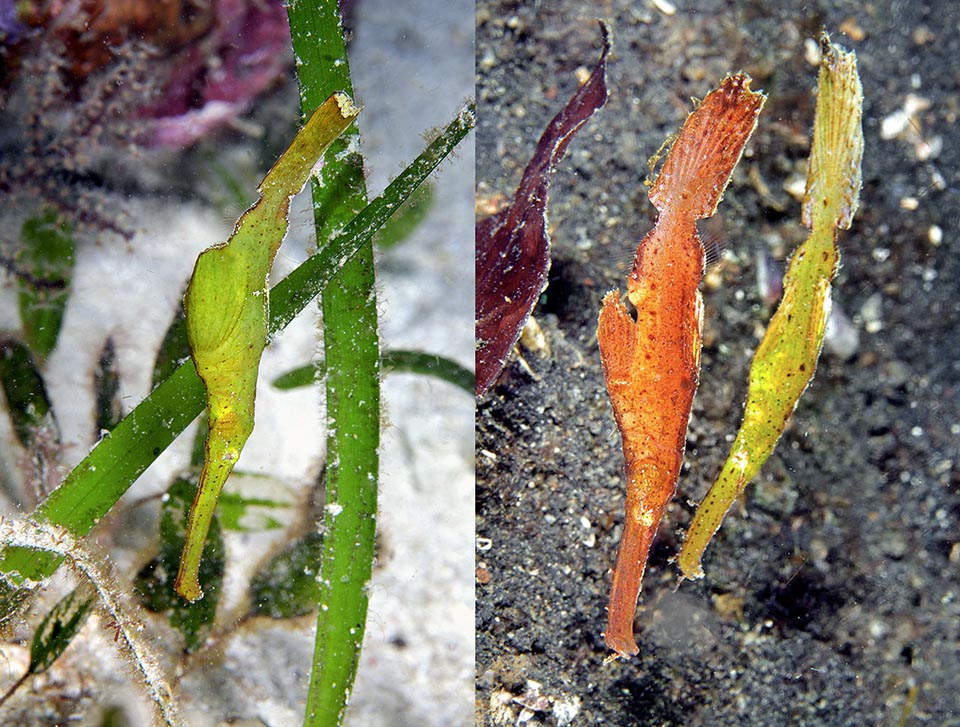
Often sways upside down in tropical Indo-Pacific, imitating the look and movement of the plants on the bottoms, and can, when useful, adapt its colour to the environment © Klaus Stiefel (left) and © Paddy Ryan (right)
With the Ornate ghost pipefish (Solenostomus paradoxus) it belongs to Solenostomidae, a small family, counting nowadays only this genus and 5 species with characters intermediate between the seahorses and the needlefishes.
Unlike these, however, the eggs are not incubated by the males but protected by the females in a showy ventral pouch born from the merging of the pelvic fins.
The genus Solenostomus, created by Lacépède in 1803, derives, composed and Latinized, from the old Greek “σωλήν” (solen) = channel, and “στόμα” (stóma), mouth, due to the united to form a tube, as indeed happens in all Syngnathiformes but the adults of the genus Bulbonaricus who lose it like Bulbonaricus brauni while growing.
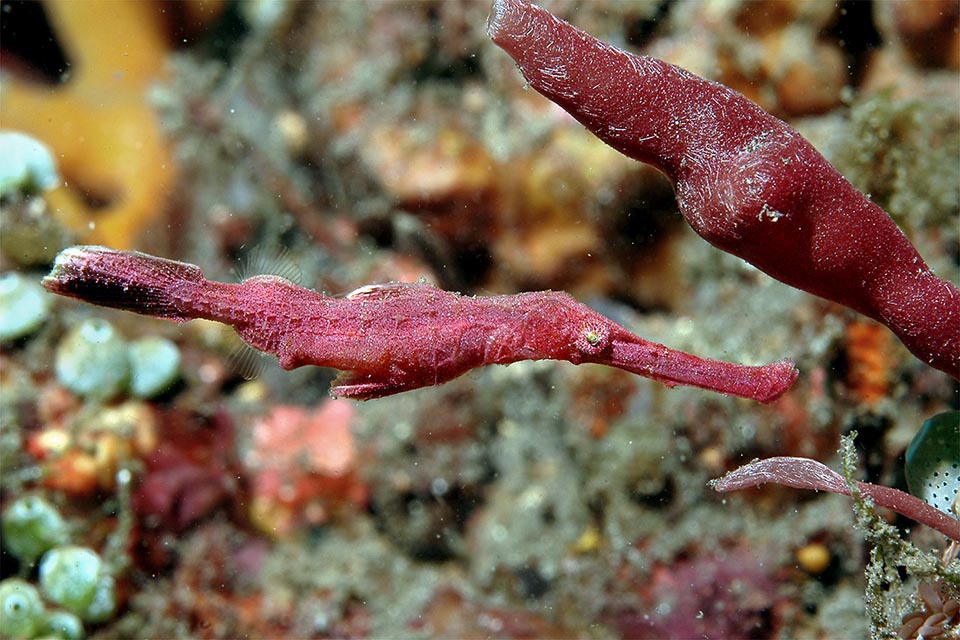
However, it has been noted that these dramatic chromatic changes are not instant and require about 36 hours © Benoit Lallement
The specific term cyanopterus also originates from old Greek “κύανος” (kúanos), blue, and “πτερόν” (pteron), wing, with reference to the dark black-bluish spots present among the spiny rays of the first dorsal fin.
Zoogeography
Solenostomus cyanopterus lives in the tropical waters of the western Indo-Pacific. Indicatively, starting from the Red Sea, is present along the coasts of Tanzania, in Mozambique, South Africa, Madagascar and adjacent islands, Comoros, Mayotte, Réunion and Mauritius. To the north, it reaches the Maldives Islands, India and Sri Lanka.
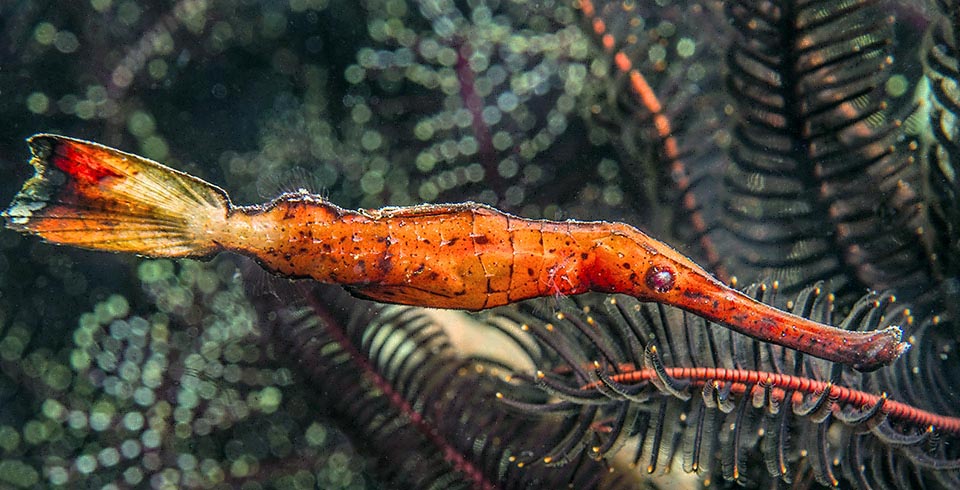
It reaches 17 cm concerning for about 1/3 the head with its long, cylindrical snout that can suck in a flash the small crustaceans and larvae of the fishes carried by currents © Rafi Amar
Then, eastwards, we find it in the Andaman Islands, in the waters of Thailand, Indonesia, Timor-Leste, Papua New Guinea and Australia up to New Caledonia.
Present in Palau, it has colonized northwards, Taiwan and Japan, and eastwards, after Guam and the Northern Marianas, Micronesia, Marshall Islands and finally Fiji Islands.
It must however be added that presently, in 2022, in this vast range under the name of Solenostomus cyanopterus circulate various species that are quite similar. Some of them have already been separated, and it is possible that with molecular biology new ones will be discovered.
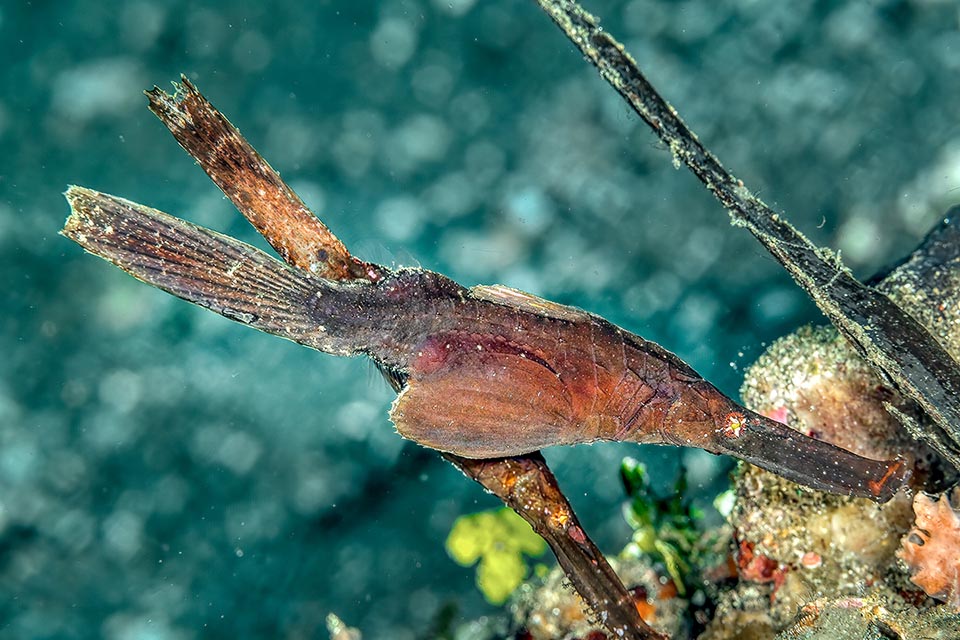
A brown couple. The Robust ghost pipefish spends most of its life in the pelagic state and reaches the bottoms only for reproducing © Sonja Ooms
For instance, Solenostomus paegnius Jordan & Thompson, 1914, differs only for the presence of thin flaps of skin that confer it a hairy look, and Solenostomus halimeda Orr, Fritzsche & Randall, 2002, specialized, as the name suggests, in reproducing in the least details the seaweeds of the genus Halimeda, has only added some camouflaging tuft.
Ecology-Habitat
Solenostomus cyanopterus is not a common and easy to observe fish. As a matter of fact, it spends most of its life in the pelagic state and reaches the bottom only when it has become adult, reproducing only once and thus concluding its existence.
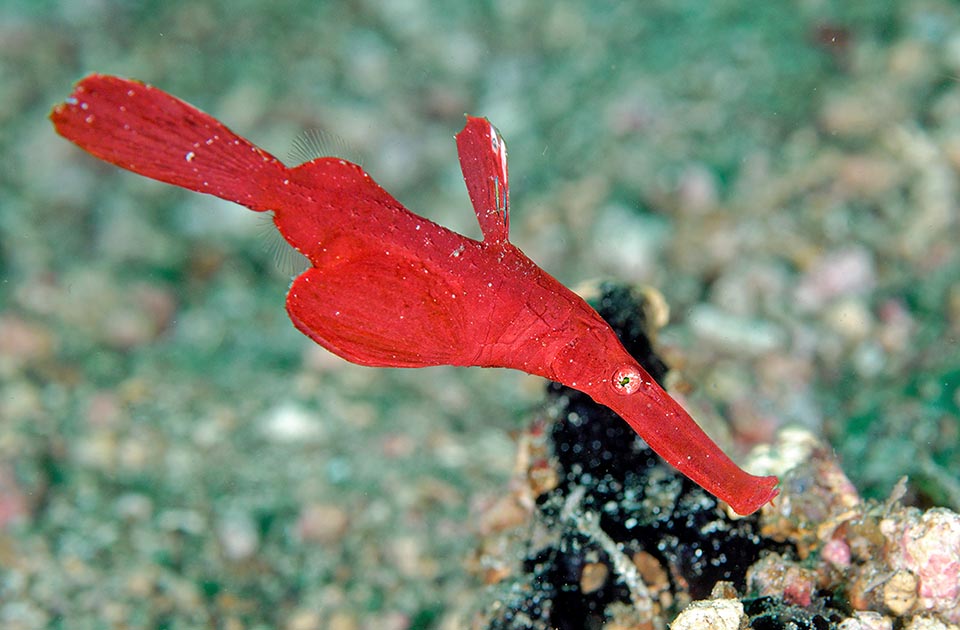
This flaming female well displays the characteristics of the species: the first dorsal fin with 5 spiny rays and two cyan spots, the great pelvic fins fused to the body to form an incubation pouch, the second dorsal fin transparent and equal to the anal, just visible on the outgrowths that precede the caudal peduncle © Benoit Lallement
Monogamous and always coupled, it may be then seen up to the depth of 25 m close to the corals or cliffs rich in seaweeds, in the submerged prairies of phanerogams and on the sandy bottom among colonizing plants and dead leaves that it imitates even in their wave motion in vertical position head down. It loves the calm waters of the lagoons and of the harbours, but ventures out also in the brackish ones of the deep and clear estuaries.
Morphophysiology
The Robust ghost pipefish, as its vulgar name states, is the biggest among the ghost fishes with a long and thin body that may reach the length of 17 cm.
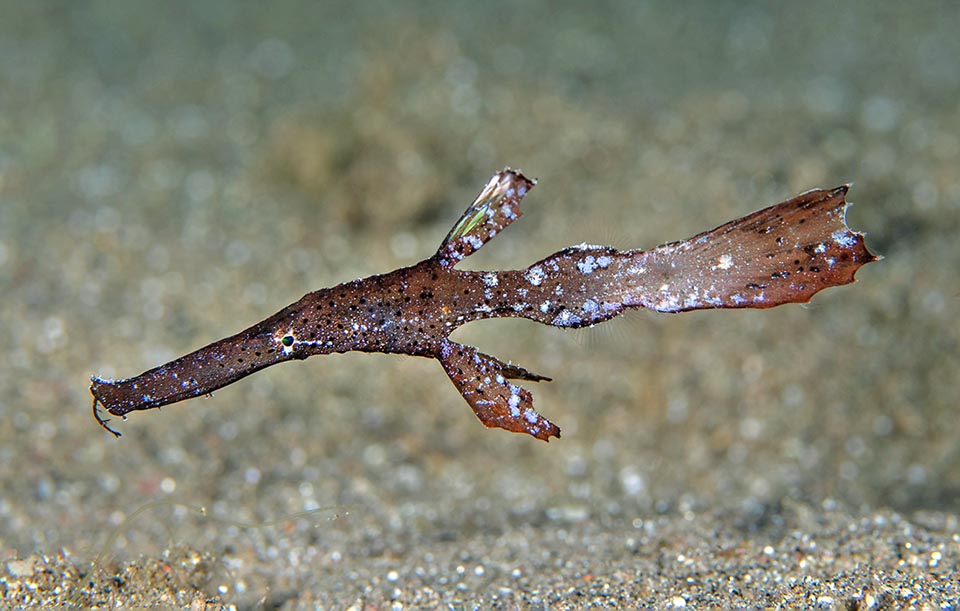
The male, smaller and slenderer, has pelvics well separated of size analogous to the first dorsal fin. On the snout tiny spines and at times ramified excrescences © Rafi Amar
It is scale less but is protected by 25-35 bony starred plates.
It may change its look within 36 hours to imitate the environment where it lives. Its livery, covered by small white and black spots imitating the foliar encrustations, can present in fact, depending on the circumstances, with green, yellow, red, brown or blackish shades.
The head, with its tubular snout and small curved spines close to the mouth, occupies about one third of its total length, and with this long tool Solenostomus cyanopterus aspirates lightning fast, like the seahorses and the seadragons, all the small crustaceans it sees around showing a marked predilection for the microscopic shrimps of the order Mysida and the larvae of the fishes that often arrive carried in mass by the currents.
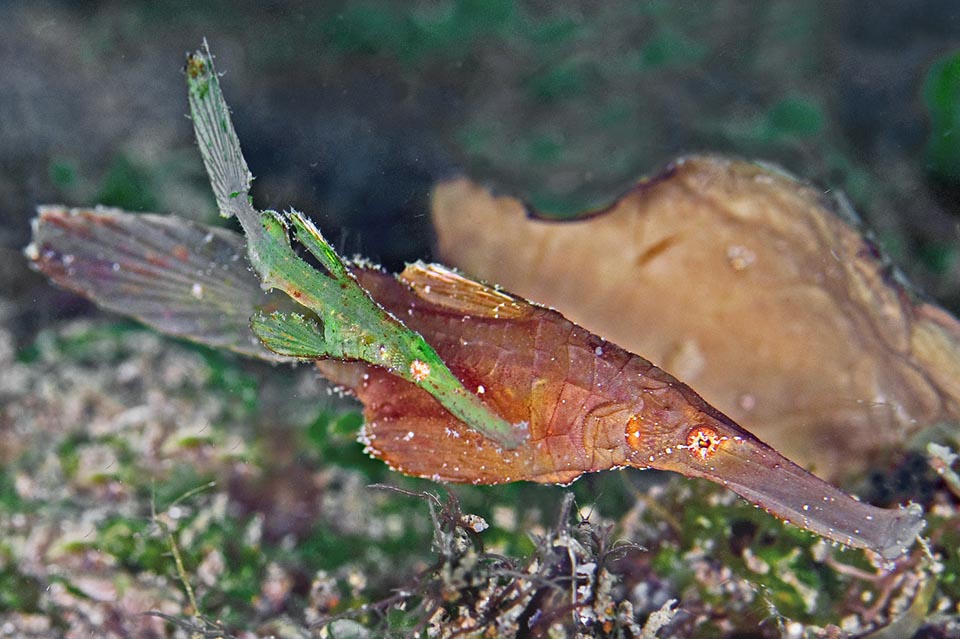
In this couple the male usually one third smaller than the female, is rather young as it can be noted from the thin and still well visible caudal peduncle © Karen Honeycutt
There are two dorsal fins. The first, relatively big with 5 spiny rays is aligned with the pelvic ones, whilst the second, equal to the anal, is low and transparent with 17-22 unarmed rays. The only way for seeing these last, is to observe with a lot of attention their attachment point, on the two large tubercle swellings placed just before the caudal peduncle.
Also the pectoral fins, close to the head, are tiny and transparent with 25-27 soft rays. Conversely, showy is the caudal fin with its 16 rays, often truncated rectangular in shape, supported by a short and thin peduncle well visible in the young males, but at times almost non-existent in the females.
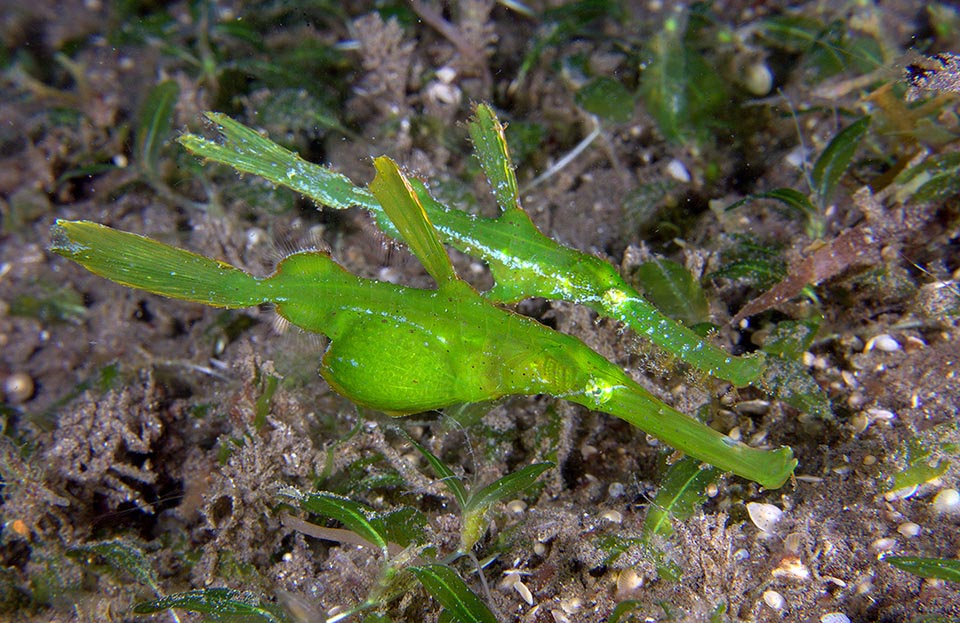
Solenostomus cyanopterus is a monogamous fish. It moves always in couples on the bottoms and reproduces only once in its life. Here the female is decidedly full of eggs © Klaus Stiefel
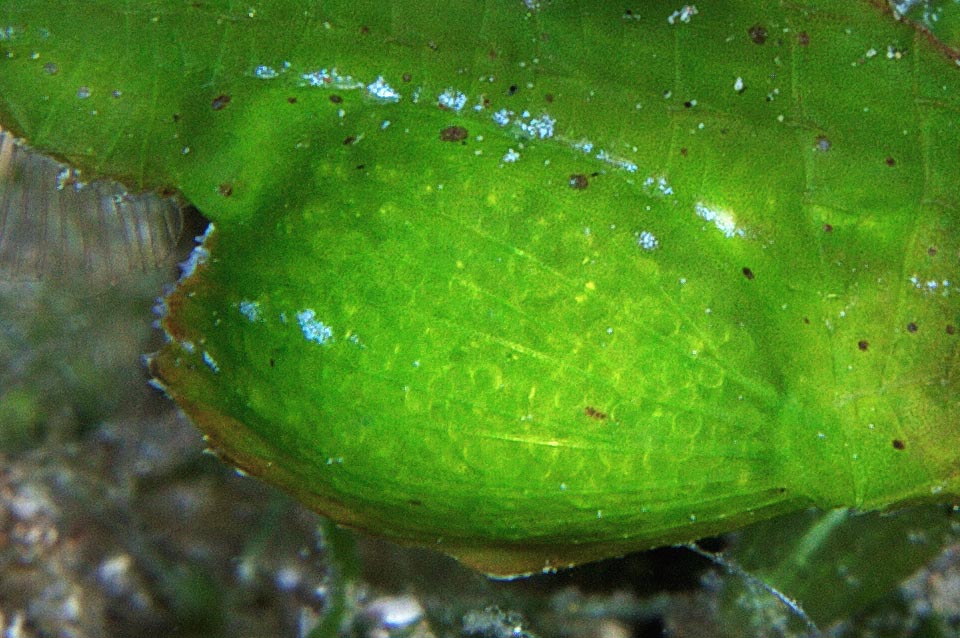
Enlarged close-up showing in transparency, under the thin skin of pelvic pouch, countless eggs. They measure less than 1 mm and hatch after about 3 weeks © Klaus Stiefel
The operculum, like in the Ornate ghost pipefish, has an unusual checkerboard design.
The sexual dimorphism is evident because the females are for about one third bigger than the males, not to forget their showy pelvic 7 rayed fins, merged at the belly to form a big pouch that may accomodate even 350 eggs. The males, slenderer, often have small ramified outgrowths on the snout.
Ethology-Reproductive Biology
The biology of this species is little known.
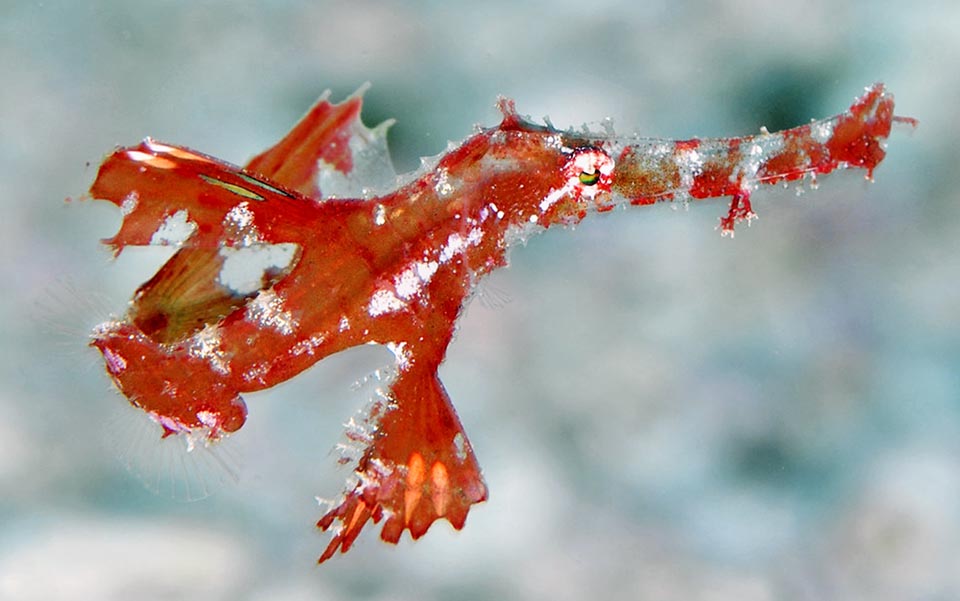
A 3 cm young. Solenostomus cyanopterus is a “Least Concern” species, that is not in danger, but under this name might hide other species of which nothing is known © Camilla Floros
After fecundation the eggs are glued on the inner side of the female pelvic fins in the ventral brood pouch where they receive feeding from the yolk and from the maternal vascularized walls. They are less than 1 mm broad, and they hatch in about 3 weeks.
Like the seahorse males, to reduce the risks linked to the dispersion, the transparent larvae are expelled in small groups staggered over time by means of successive contractions.
The newborns are transparent and like in the Ornate ghost pipefish the rays of the fins are proportionally very long compared to the adults, more suitable for swimming during their ling pelagic life.
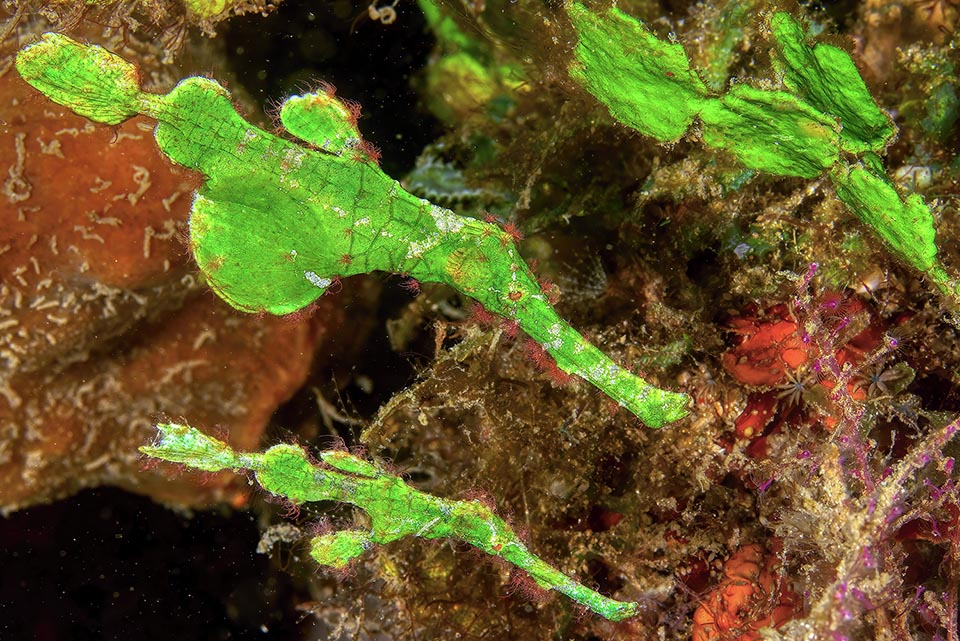
Some have already been separated, like Solenostomus halimeda, above, that imitates the seaweeds of the genus Halimeda. Apart some characteristic camouflaging tuft it is at first sight identical to the genus Solenostomus cyanopterus. In the next years, with the molecular biology, the 5 species of the genus Solenostomus might even increase © Sonja Ooms
They measure about 3 mm and come to life with the eyes already pigmented, the backbone visible and a small aspirating tube
The Robust ghost pipefish is not hunted by man and does not interest even the aquarists because of the difficulty in nourishing it and the short duration of its life. The fishing vulnerability risk, very low, marks only 10 in a scale of 100 and in the Red List Solenostomus cyanopterus appears presently low risk (Least Concern, LC).
Synonyms
Solenostomus bleekerii Duméril, 1870; Solenostomatichthys bleekeri (Duméril, 1870); Solenichthys raceki Whitley, 1955.
→ For general information about FISH please click here.
→ For general information about BONY FISH please click here
→ For general information about CARTILAGINOUS FISH please click here.
→ To appreciate the BIODIVERSITY of BONY FISH please click here.
→ To appreciate the BIODIVERSITY of CARTILAGINOUS FISH please click here.
